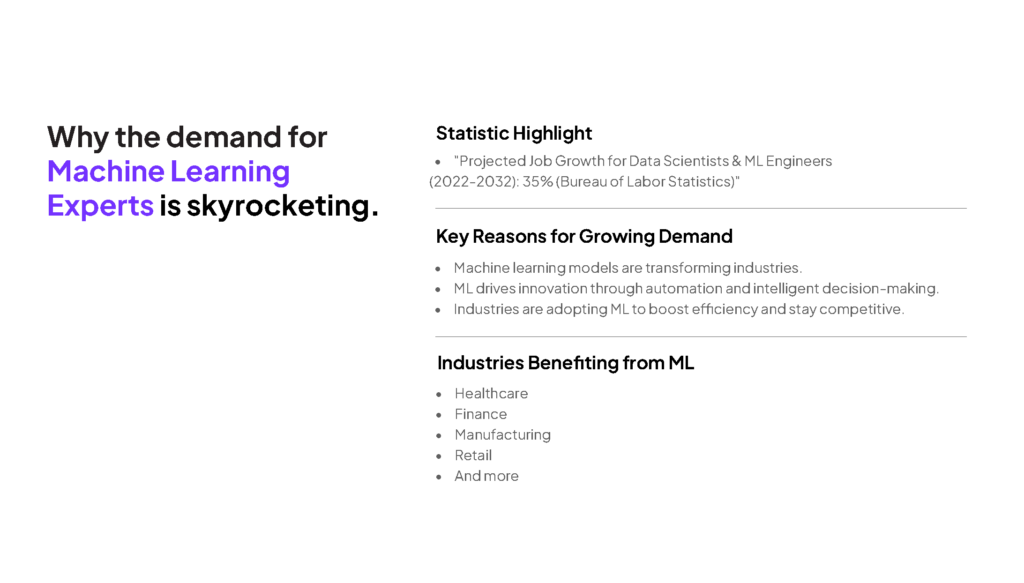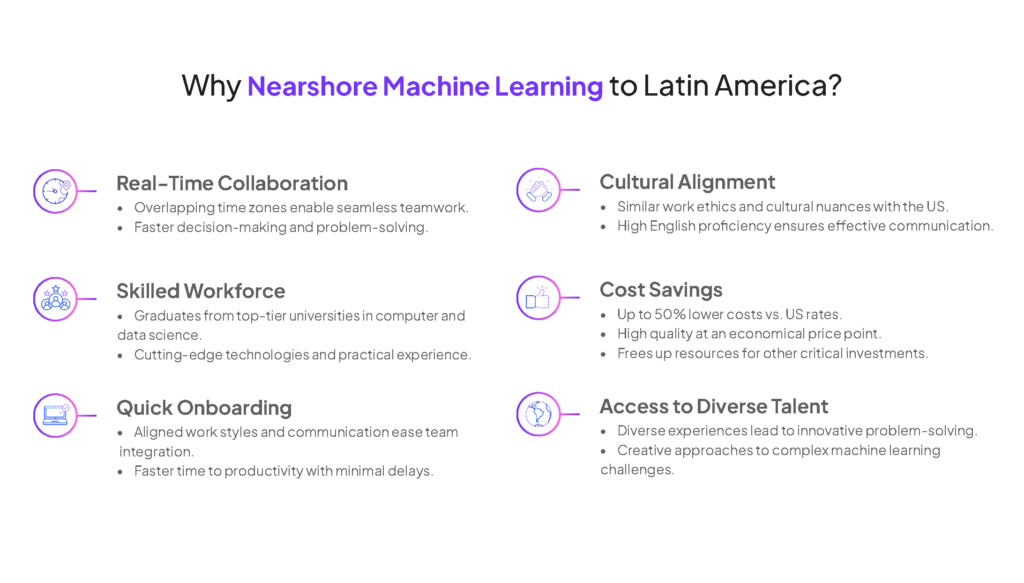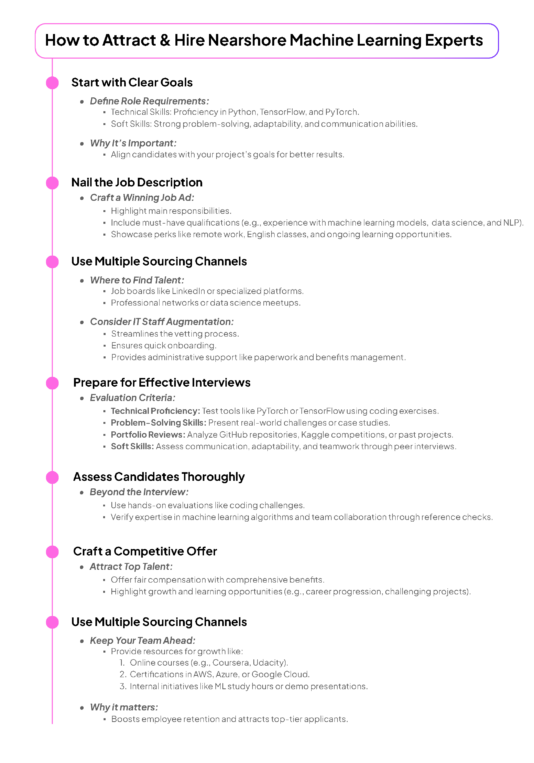Artificial intelligence (AI) is no longer a futuristic concept—it’s here, and it’s transforming industries quickly. From personalized recommendations in e-commerce to predictive analytics in healthcare, AI adoption is now essential. At the heart of this transformation lies machine learning (ML), which is key for companies leveraging data-driven strategies that can make the difference between leading the industry or falling behind.
However, finding machine learning experts with the right skill set, on time, and within budget is not an easy task. It involves knowing where the talent is and how to attract it, as well as how to evaluate their capabilities. For this, a solid vetting process and a specialized human resources team are necessary, or you can rely on IT staff augmentation companies to handle this work for you.
This guide is crafted for US-based tech companies navigating the complexities of machine learning (ML) hiring. We’ll break down every step—from identifying the right roles to sourcing and onboarding top engineers—while explaining how nearshoring and staff augmentation can help you build high-performing, future-ready ML teams.
What Is a Machine Learning Expert?
A machine learning expert is a professional with extensive knowledge in computer science who designs algorithms and models that enable systems to learn from historical data. This expertise allows them to predict new outcomes and refine these predictions as fresh data becomes available.
Machine learning experts are instrumental in implementing solutions ranging from fraud detection and malware scanning to predictive maintenance and automating business processes, making them indispensable to leading organizations.
Why the Demand for ML Experts Keeps Growing
According to the Bureau of Labor Statistics, jobs for data scientists and ML engineers are projected to grow 35% between 2022 and 2032—well above the average for all occupations.
The growing importance and future prospects of machine learning engineering are evident, with a significant increase in demand for skilled professionals in this field. Machine learning models are becoming integral to various industries, driving innovation and efficiency through automation and intelligent decision-making.

Core Machine Learning Expert Roles Explained:
Machine learning experts can fulfill various roles, though this doesn’t necessarily mean they are different professionals. However, these roles can be categorized into:
- Machine Learning Engineers: These professionals are responsible for building and deploying ML models into production environments. They possess expertise in programming languages like Python and are adept at using frameworks such as TensorFlow and MLOps tools. Their primary role is to ensure that machine learning models are efficiently integrated and operational within software systems.
- Deep Learning Specialists: Focused on neural networks and advanced AI applications, these specialists work on cutting-edge projects involving computer vision and natural language processing (NLP). Their work often involves developing complex models that require significant computational power and expertise in deep learning frameworks.
- Data Scientists: These experts analyze complex datasets to develop hypotheses and build models that guide business decisions and enhance machine learning pipelines. They are skilled in data science techniques and tools, enabling them to extract meaningful insights from data and support strategic decision-making.
- Data Engineers: Data engineers are crucial in facilitating the integration of machine learning models with data systems. They are proficient in data engineering tools and techniques, ensuring seamless data flow and processing. Their work supports various aspects of AI and software development by enabling better data-driven decision-making.
Together, these roles form the foundation of any AI-driven development team.
If you’re building AI-powered products and need to scale fast, you can hire AI engineers with expertise across machine learning, deep learning, NLP, and data engineering.
Key Differences:
- Focus Area: Machine Learning Engineers focus on deploying models, Deep Learning Specialists on advanced AI applications, Data Scientists on data analysis and model building, and Data Engineers on data integration and processing.
- Skill Set: Machine Learning Engineers need strong programming and MLOps skills, Deep Learning Specialists require deep learning expertise, Data Scientists need analytical and statistical skills, and Data Engineers need data engineering and processing skills.
- Role in the Workflow: Machine Learning Engineers and Data Engineers are more involved in the technical implementation and integration of models, while Deep Learning Specialists and Data Scientists focus on model development and data analysis.
Machine Learning Services and Technologies
Staying up-to-date with the latest machine learning services and technologies is crucial for maintaining a competitive edge. Here are some key technologies to consider:
Key Technologies to Consider:
- Deep Learning Frameworks: TensorFlow, PyTorch, and Keras are among the most popular deep learning frameworks. They offer a range of tools and libraries for building and deploying machine learning models, making them essential for any machine learning engineer.
- Natural Language Processing (NLP): NLP is a critical component of many machine learning applications. Technologies like NLTK, spaCy, and Stanford CoreNLP provide powerful tools and libraries for text processing and analysis, enabling the development of sophisticated NLP models.
- Computer Vision: The field of computer vision is rapidly growing, with applications in areas like image recognition and video analysis. Technologies such as OpenCV, Pillow, and scikit-image offer robust tools and libraries for processing and analyzing visual data.
- Cloud-Based Machine Learning Platforms: Cloud platforms like AWS SageMaker, Google Cloud AI Platform, and Microsoft Azure Machine Learning provide comprehensive tools and services for building, deploying, and managing machine learning models. These platforms offer scalability and flexibility, making them ideal for large-scale machine learning projects.
- Model Development and Deployment: Effective model development and deployment are critical for the success of machine learning projects. Tools like Docker, Kubernetes, and TensorFlow Serving provide the infrastructure needed to build, deploy, and manage machine learning models efficiently.
By leveraging these technologies, you can enhance your machine learning capabilities and stay ahead in the rapidly evolving field of AI. Whether you’re developing new machine learning models or optimizing existing ones, staying informed about the latest tools and services is essential for success.
Why Nearshore Machine Learning Engineers Is the Smart Move
Nearshoring refers to outsourcing work to nearby countries with compatible time zones and cultures. Latin America has emerged as a prime destination for US businesses wanting to hire machine learning engineers due to its growing reputation as a tech hub.
Benefits of Machine Learning Nearshoring:
- Real-time collaboration: Thanks to overlapping time zones, teams can work together seamlessly, allowing for faster decision-making and problem resolution. This enables more synchronized workflows and enhances productivity.
- Strong cultural alignment: Latin American countries share similar work ethics and cultural nuances with the US, facilitating smoother communication and collaboration. Additionally, many professionals in the region have high English proficiency, further bridging communication gaps and ensuring effective teamwork.
- Well-educated tech workforce: The region boasts a plethora of top-tier universities producing skilled graduates in computer science, data science, and machine learning. These institutions emphasize cutting-edge technologies and practical experience, ensuring a workforce ready to tackle complex machine learning projects.
- Significant cost savings: Companies can achieve up to 50% lower costs compared to US rates without compromising on quality, making it an economically viable option. This allows businesses to allocate resources more strategically and invest in other critical areas of development.
- Reduced onboarding time: Due to aligned work styles and communication preferences, integration into existing teams is generally quicker and more efficient. This reduces the time to productivity and allows projects to progress without unnecessary delays.
- Access to diverse talent: The diverse backgrounds and experiences of LatAm engineers contribute to innovative problem-solving and creative approaches to machine learning challenges. This diversity can be a significant asset in developing robust and adaptable machine learning solutions.
Moreover, many LatAm engineers possess extensive experience collaborating with US companies, which makes cross-border integration smoother than hiring from distant offshore locations. With the right partner, companies can gain long-term collaborators—not just temporary contractors.
Despite these advantages, some companies remain unaware of or hesitant about hiring developers from LatAm. That’s where BEON comes in—offering a seamless, compliant, and efficient process to access top ML talent from the region.
Discover more in our post on LatAm’s tech talent surge.

How to Attract & Hire Nearshore Machine Learning Experts
Hiring machine learning experts requires both a strategic approach and careful attention to detail. If you’re looking to build a strong team of machine learning professionals, this section will walk you through the entire process—from defining the role to crafting the right offer.
Start With Clear Goals
Before you begin sourcing candidates, take time to establish exactly what you’re looking for. Clearly outlining the responsibilities and essential skills for the role is crucial for attracting the right individuals.
Key considerations for defining the role include:
- Technical Skills: Expertise in tools like Python, TensorFlow, and PyTorch.
- Soft Skills: Strong problem-solving, adaptability, and communication abilities.
By understanding these needs upfront, you’ll ensure candidates align with your project goals.
Nail the Job Description
A compelling job description is your first opportunity to grab a candidate’s attention. Highlight the key responsibilities, expected qualifications, and any standout aspects of the role.
Your job description should include must-have technical experiences, such as proficiency in machine learning models, data science, and natural language processing. Clearly stating your expectations will help filter for the most qualified applicants.
Additionally, don’t forget to include the essential perks and benefits the company offers. Things like English classes, a remote-first approach, or other incentives can make a big difference in attracting top machine learning talent, showcasing what your workplace has to offer.
Leverage Multiple Sourcing Channels
Identifying talented professionals requires casting a wide net across multiple sourcing channels, including:
- Job Boards: Platforms like LinkedIn or specialized sites for tech talent.
- Professional Networks: Use social platforms or attend data science meetups to find experts.
However, if your team lacks the time or in-house HR resources to manage a full hiring process, IT staff augmentation can be an ideal alternative.
Unlike traditional sourcing methods, IT staff augmentation agencies handle the entire vetting process to ensure candidates match 100% with your needs. They also take care of onboarding, from paperwork to providing equipment, so new hires can start adding value from day one. This approach not only saves time and budget but also minimizes risks like worker misclassification.
Some IT staff augmentation companies, like BEON.tech, go a step further by acting as an employer of record. They manage employee benefits and work-life balance, keeping professionals engaged and committed to their roles, which directly improves retention. If you’re looking for a faster, more efficient way to build your team, IT staff augmentation is a solution worth considering.
Prepare for Effective Interviews
The interview stage is where you’ll assess both technical skills and cultural fit. Make your process rigorous but fair by focusing on critical areas, including:
- Technical Proficiency: Test candidates’ skills with coding exercises and their familiarity with tools like PyTorch, scikit-learn, and TensorFlow.
- Problem Solving: Present real-world case studies or challenges to assess their analytical capabilities.
- Portfolio Reviews: Examine their GitHub repositories, Kaggle competitions, or previous projects.
- Soft Skills: Look for collaboration, adaptability, and communication abilities.
Including peer interviews or domain-specific problem-solving exercises can provide additional insight into how the candidate will contribute to your team.
Assess Candidates Thoroughly
Beyond the interview – What comes next?
Use hands-on evaluations to uncover a candidate’s true potential. This might include coding challenges, technical tests, and reference checks.
Key attributes to verify include their understanding of machine learning algorithms, real-world experience with models, and their ability to work efficiently within a team structure.
Craft a Competitive Offer
Once you’ve identified the perfect candidate, seal the deal with a competitive offer. Include elements like:
- Fair Compensation
- Comprehensive Benefits
- Growth Opportunities
Machine learning experts value roles that offer career progression, continuous learning, and exciting challenges. By emphasizing these in your offer, you’ll increase your chances of landing top talent.
Encourage Continuous Learning
Want to retain top talent? Prioritize growth.
The AI and machine learning industry evolves rapidly, and ongoing education is key to staying ahead. Foster a learning culture in your company by offering resources such as these:
- Online Courses: Platforms like Coursera and Udacity provide valuable training.
- Certificates: Encourage certifications in AWS, Azure, or Google Cloud ML services.
- Internal Initiatives: Host demo days or ML study hours to keep your team engaged.
Investing in your team’s development not only benefits them but also strengthens your business by boosting retention and attracting more top-tier professionals. Learn more about this in our article on keeping top talent.

Best Alternatives to Hire A+ Machine Learning Experts
When it comes to hiring machine learning talent, there are multiple engagement models you can consider, each offering unique advantages and challenges. Whether you’re looking to fill roles for a single project or build a long-term team of experts, the right hiring method depends on your specific goals, budget, and timelines.
Let’s take a closer look.
Comparing Hiring Approaches for Machine Learning Experts
1. In-House Hiring
Bringing machine learning experts on board as full-time employees is ideal for organizations seeking seamless collaboration and robust team integration. This approach offers you complete control over operations, helping align your talent with the company’s goals.
Pros:
- Full control over processes and team alignment
- Better integration with company culture and strategies
Cons:
- Time-intensive hiring process
- Requires significant resources in a competitive job market
Best For:
Organizations ready to invest in a permanent and scalable in-house AI or data science team.
2. Staff Augmentation
Staff augmentation allows companies to quickly scale their teams by hiring pre-vetted experts through a staffing agency. This method provides flexibility without the long-term commitment of a full-time role.
Pros:
- Access to a global talent pool
- Fast onboarding, usually within days
- Flexibility to scale up teams on-demand
- Avoid classification risks and administrative hurdles
Cons:
- Limited control over onboarding
Best For:
Scaling quickly during ongoing machine learning projects or post-funding rounds. Especially beneficial for startups or companies building agile teams.
3. Freelance or Contract Hiring
Freelancing platforms are convenient when you need flexibility and quick results. This option is often the go-to solution for specific, short-term tasks requiring machine learning expertise.
Pros:
- Affordable for short-term projects
- Flexibility to hire per project requirements
- Broad talent pool for niche tasks
Cons:
- Variable quality and inconsistent results
- Requires hands-on project management and oversight
Best For:
One-off tasks like building models, data cleaning, or running experiments. Ideal for startups testing ideas or proof-of-concept models.
4. Outsourcing
Outsourcing machine learning projects to third-party firms brings in advanced expertise and resources for complex, large-scale projects. However, it comes at the cost of reduced control.
Pros:
- Access to cutting-edge capabilities and experienced teams
- Focus on complex areas like computer vision, deep learning, or NLP
Cons:
- Higher overall costs
- Less direct control over execution and timelines
Best For:
Enterprise-level projects requiring deep specialization in machine learning techniques.
Making the Right Hiring Choice
As you can see, each hiring method serves different needs:

By weighing the trade-offs of each approach and leveraging the right sourcing platforms, you’ll put your business on the fast track to Machine Learning success.
Go One Step Further: Scale Your Tech Team with BEON.tech
When hiring machine learning engineers, relying exclusively on in-house hiring can be slow, expensive, and unpredictable. That’s where BEON.tech comes in. By leveraging machine learning nearshoring, we help your business access elite talent, reduce overhead, and fast-track your AI roadmap.
Why choose BEON.tech for machine learning talent?
- Cost-Effective Efficiency: Gain access to highly skilled ML experts without the extra costs of in-house hiring.
- Elite Quality: Tap into Latin America’s top 1% of talent experienced in diverse ML frameworks and technologies.
- Speed and Flexibility: Build or scale your team quickly to meet your project timelines.
With a strategic hiring plan and clear goals, you’ll set the foundation for a machine learning team that meets today’s demands while preparing for tomorrow’s innovations. Start building your world-class machine learning team today. Contact BEON.tech to hire from Latin America’s top 1% of tech talent. Schedule a call today.
Explore our
Employer of Record (EOR) Services: Your Key to Hiring IT Talent Globally
The global tech industry is evolving rapidly, with companies increasingly looking beyond their local markets to find the best talent. Latin America has emerged as a prime destination for hiring skilled software developers due to its growing talent pool, cost advantages, and favorable time zones. However, expanding into new markets comes with challenges, particularly in…
Why DevOps Is a Game-Changer for Companies and Developers
No matter where your company stands in its tech evolution, DevOps can transform how you operate. Having worked as a DevOps Engineer on various projects, I’ve seen firsthand the difference it makes. Without a dedicated DevOps presence, companies often struggle with slow deployments, inconsistent workflows, and inflated costs. The integration of DevOps can turn this…
Understanding Employee Misclassification Penalties & How to Avoid Them
Hiring independent contractors can be a strategic move for software companies looking to scale quickly while optimizing costs. However, misclassifying independent contractors as employees—or vice versa—can lead to severe financial, legal, and reputational consequences. In recent years, governments worldwide have tightened regulations to combat employment misclassification, imposing heavy fines and back taxes on businesses that…






